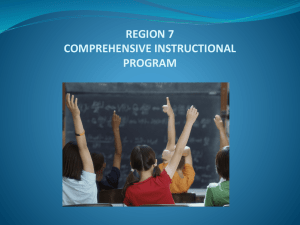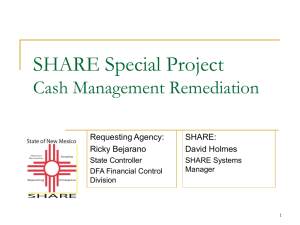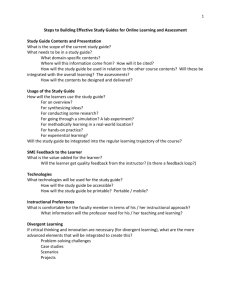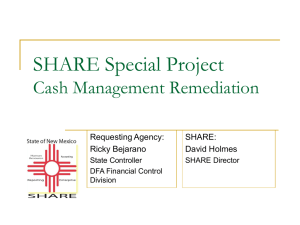Providing Tailored Instruction with the Assessment and
advertisement
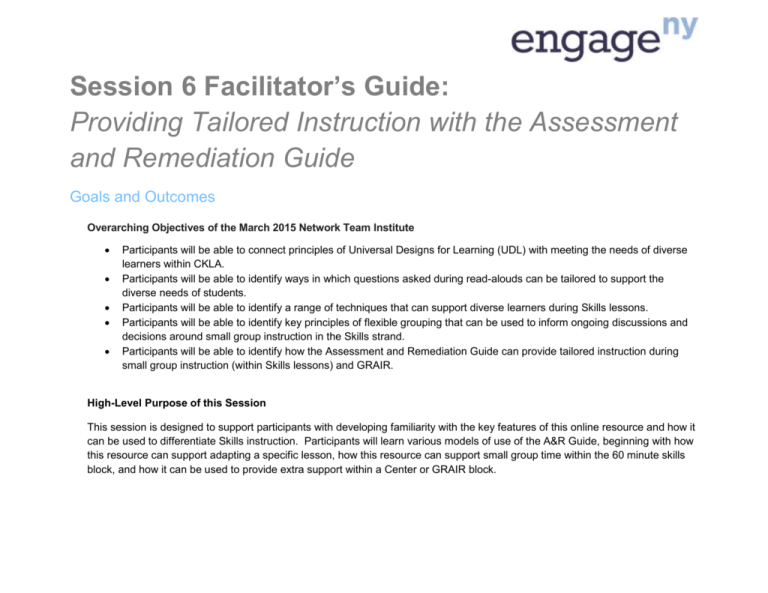
Session 6 Facilitator’s Guide: Providing Tailored Instruction with the Assessment and Remediation Guide Goals and Outcomes Overarching Objectives of the March 2015 Network Team Institute Participants will be able to connect principles of Universal Designs for Learning (UDL) with meeting the needs of diverse learners within CKLA. Participants will be able to identify ways in which questions asked during read-alouds can be tailored to support the diverse needs of students. Participants will be able to identify a range of techniques that can support diverse learners during Skills lessons. Participants will be able to identify key principles of flexible grouping that can be used to inform ongoing discussions and decisions around small group instruction in the Skills strand. Participants will be able to identify how the Assessment and Remediation Guide can provide tailored instruction during small group instruction (within Skills lessons) and GRAIR. High-Level Purpose of this Session This session is designed to support participants with developing familiarity with the key features of this online resource and how it can be used to differentiate Skills instruction. Participants will learn various models of use of the A&R Guide, beginning with how this resource can support adapting a specific lesson, how this resource can support small group time within the 60 minute skills block, and how it can be used to provide extra support within a Center or GRAIR block. Learning Experiences This training assumes general prior knowledge about K-2 CKLA. For schools, teachers, or administrators who are interested in knowing more about Core Knowledge, there are prior training modules posted on EngageNY.org that provide this general support (Professional Development Turnkey Kit: Grades P-2 ELA for Teachers & Principals - Module 1a: https://www.engageny.org/resource/professional-development-turnkey-kit-grades-p-2-ela-teachers-principals-module-1a). Session Outcomes What do we want participants to be able to do as a result of this session? Participants will be able to describe how the Assessment and Remediation Guide can provide tailored instruction during small group instruction (within Skills lessons) and GRAIR. How will we know that they are able to do this? Questions posed during Gallery Walk and Findings through a Case Study. Session Overview Section Time Section 1 Structure and Contents of the A&R Guides 45 min. Section 2 45 min. Planning Targeted Instruction with the A&R Guide Overview Prepared Resources Participants review the tools and key features of the A&R Guide and examine these components through a gallery walk. A&R Guide posters for gallery walk Participants use the A&R Guide to develop a targeted lesson for a student described in a case study. Case study Facilitator’s Preparation Session Roadmap Section 1: Structure and Contents of the Assessment and Remediation Guide Time Slide #/Pic of Slide Script/Activity directions Time: 45 min Grouping Slide 1 Slide 2 WG Slide 3 Key Point: Share session objective. WG Slide 4 Key Points: As you can see here, these A&R Guides look just like the Teacher’s Guides (TG), they are color coded by grade. The A&R Guide, however, is not a TG replica. There is a guide for each grade level for grades K-2 and a guide for each unit in grades K and 1. In grade 2 there is one guide that includes a comprehensive WG review of phonics The guide can be used in tandem with the Skills Strand Guide or as a substitute for students requiring specific support. It is designed for 1:1 or small group settings. Slide 5 Key Points: • Resources from the Assessment and Remediation Guide can help to support scaffolds and adaptations to differentiate Skills lessons. • Activities can be planned using the A&R guide to support individualized tailored lessons, targeted small group instruction, or reinforcement of skills activities used in centers during GRAIR. WG Slide 6 Key Points: The A&R Guides are an online only resource. These resource guides consist of both assessment and remediation materials that go beyond the Pausing Point materials typically included at the end of each Skills unit. These materials can be printed as needed WG Slide 7 and used for reteaching and/or as additional practice for students experiencing difficulty. To access the guides from the Core Knowledge website, visit http://www.coreknowledge.org/ckla-files. There you will be prompted to sign up for the CKLA Free download manager. From the Engageny website you would click the common core icon; you’ll see a list of grade levels. Click on the grade level of interest. You will be brought to a grade level landing page. Scroll down to the bottom where the materials are located. For Kindergarten and first grade, the A&R Guides are housed next to the materials for each unit. Find the individual skills units, and click on the A&R Guide for the unit. In second grade the link is located before all of the skills unit material. It contains the whole guide and is located in one place. Key Points Use these hyperlinks to access the specific Assessment and Remediation Guide Unit you need (i.e., when assessment data and instructional performance signal a need for remediation). WG Slide 8 Key Points: The Assessment and Remediation Guide is a large resource and is different for each grade. Learning about the structure and resources will help to find and implement the activities to effectively meet the needs of students at a targeted level. WG Slide 9 Key Points: WG • The Assessment and Remediation Guides look different for each one of the grades. • Differences in the skills addressed at each grade level reflect the priorities for remediation accordingly. • In Kindergarten, phonological awareness covers awareness of environmental sounds through • • • Slide 10 manipulating three to five phonemes. Understanding directionality is only in Unit 1, and the writing sections address letter formation for handwriting. In all grades, the phonics sections address reading and spelling words with the sound-spellings in the code taught up to that point. Fluency and Comprehension sections address reading connected text with ease, expression, purpose, and understanding. In Grade 1 grammar concepts are included in this section. Grade 2 is a comprehensive review of phonics taught in grades K-2— what Core Knowledge calls the Basic Code and the Advanced Code of the sounds and spellings in the English Language. Key Points: • The Kindergarten and Grade 1 A&R Guides directly parallel the sequence of instruction from the Teacher Guides. • Note: There are no A&R guides for the final unit because of overlap of the last unit in one grade and the first unit in next. • The Skills units in K and 1 build WG • • • Slide 11 incrementally, meaning that mastery of the skills taught in earlier units is assumed and therefore a prerequisite for success in later units. Work at any given step of the sequence assumes Code Knowledge leading up to that point. During a lesson, or over the course of a few lessons, if you notice that students are struggling with a specific instructional task like chaining, or if the results from the placement or unit assessments suggest that there is a specific area of need, the A&R Guide is designed to help you figure out how to support children, but you will NOT find a matching specific Lesson 7 for Unit 3. Rather it is organized by the matching content area and the learning goals for this unit. You will go to the section of the A&R Guide that matches the SKILLS children need support on. For children with global difficulties, you want to work to pay specific attention to the areas of need that you may want to zoom in on at any particular point. Key Points: The Grade 2 A&R Guide is one complete resource for phonics instruction only. The Guide is intended for use with students who have mastered some or most of the letter-sound correspondences in the English Language, but who are not WG Slide 12 yet fluent readers because they lack specific decoding skills and/or have not had sufficient practice in reading decodable text. It is designed for targeted remediation of specific gaps of code knowledge. Students who are significantly below grade level will need intensive instruction utilizing resources from previous grade levels. Use the sequence of skill instruction as presented in the Table of contents as the order in which specific gaps should be addressed for students who have multiple gaps. The lessons in the Grade 2 Guide build incrementally as well, meaning that the mastery of the skills taught in earlier lessons is assumed and therefore a prerequisite for success in future lessons. Key Points: The A&R Guide is a comprehensive guide that includes: 1. Sample Lessons 2. Word /Chaining Lists 3. Activities for Reteaching 4. Games for Reinforcement 5. Progress Monitoring Assessments 6. Resources Transition: Let’s look at samples of each of WG these features now. shutterstock_503822 (Copyright: Lisa F. Young) Slide 13 Key Points: • The A&R Guide offers the guidance to helping you determine a student’s level of instructional need. • There are three levels of instructional need defined by the Guides. • The first is Guided Reinforcement, which is a fifteen minute lesson to help students strengthen a skill that has already been taught, but with which the child requires extra practice. • The second level of instructional need is Explicit Reteaching, which provides students with 25 minutes of practice on any skill. • The third level is Comprehensive Reteaching, which is a 45 minute lesson used when a student is one grade below level, and requires reteaching in more than one skill. • All three levels are defined in the Guides WG for particular skills and samples of lessons are provided alongside lesson templates to guide your planning and building of lessons that fit the specific needs of individual students or small groups. Slide 14 Key Points: The A&R Guides include words lists and chaining lists that teachers can build into a lesson for students to use in order to practice mastery of lettersound correspondences identified as weaknesses. These lists include words that are aligned to the specific letter-sound correspondences taught up to the specified unit. Examples of using these lists include: o Teachers might copy a word list and attach it to a pocket chart. Students can then work with a partner while one reads the words from the chain and the other student builds the word with letter cards in the pocket chart. o Teachers might use the lists at writing centers specifically for “chain and copy” exercises. Students form pairs and they take turns as one student reads a words in a chain and the other WG student writes the words on paper—switching to complete a new chain. Slide 15 Key Points: • The A&R guide includes activities to be used for reteaching. • The expectation is to have these activities facilitated by the teacher. • Some activities are familiar to the students from the Teacher Guides; others have been adapted or are new. • These activities are engaging and the purpose of these is to strengthen and support instruction and to have a backand-forth exchange between student and teacher. • For example, there are worksheets for some activities to support the structure of the lesson and the teacher is intended to work alongside the students, providing inthe-moment guidance and feedback for remediation. This is what will help to increase a student’s level of success with the focus skill. • Some activities are carried over from the Teacher Guides (e.g., Chaining), some are adapted (e.g., applying the Baseball Game to varied content), and some are new to allow for fresh instruction (e.g., working with Sound Boxes). WG Slide 16 Key Points: Skills-aligned games are included to provide engaging and differentiated opportunities for students to practice targeted skills in small group instruction or during center work. Teachers will need to make/prepare these games in advance. Templates and instructions are provided for each suggested game. These are referred to during the Pausing Point sections of the Teacher Guides and/or A&R Guides. Slide 17 Key Points: Placement and Student Performance Assessments are provided in the Teacher Guides. To supplement these, the A&R Guide provides Progress Monitoring Assessments specific to each skill you may be targeting for remediation. These assessments can be used diagnostically to inform instruction and systematically to contribute to a record of student progress. Slide 18 Key Points: There are also additional resources included in the Assessment and Remediation Guide. These include articles that provide the WG SG Slide 19 rationale for how we teach CKLA Skills, which are also included in the appendices in the back of the Teacher’s Guides. However, other resources won’t be found in the Teacher Guides, but can be a huge support for instruction; these include: o an Articulation Chart to help you guide students in becoming aware of what their lips, tongue and voice boxes are doing when they say sounds, o a Figuring Out Words Chart with some decoding strategies that can be posted, o a Comprehension Master Thinking with Reading Chart with before/during/after reading strategies, and o a Concepts of Print Checklist that can be used when assessing students in this area. Activity: TRAINERS NOTE: sections from the A&R Guides should be displayed in the room for participants to examine samples for the applicable grades. SG & I Slide 20 Frame Gallery Walk: The A&R Guide for each grade features different components. Around the room we have placed a Gallery Walk A&R Guide components posted in specific grade levels. You will also see A&R Guide aligned activities displayed. I will be available for questions during the gallery walk. We will reunite as a whole group for Q&A. Activity: Participants will participate in a gallery walk where they will observe key features of the Assessment and Remediation Guide at the grade level they teach (or if they are a coach or administrator, they will review several grade levels). Each display will include examples of key structural components (labeled) as well as Slide 21 examples and activities related to each implementation model. As participants review the samples, they should note any questions that they have and/or ideas for how to best use the A&R Guides. As participants walk around room, facilitators will be available to answer questions. Debrief: Participants share examples of how they can use the A&R Guide. Participants will also have an opportunity to ask any questions that they may still have. Shutterstock_80225563 Section 2: Planning Targeted Instruction Time: 45 min Time Slide #/Pic of Slide Slide 22 Script/Activity directions Grouping WG Slide 23 Key Points: There are different points of entry that may have brought you to the Assessment and Remediation Guide. Through observation of student performance during instructional tasks, from the results of assessments administered from placement tests, pretests, end of unit assessments. When you receive new students and you need to establish a baseline, or to progress monitor students. WG shutterstock_123013096 (Copyright: Samuel Borges Photography) Slide 24 Key Points: (summarize Kayla’s story) Kayla completed the Kindergarten, Unit 6 End of Unit Assessments Walk through process of using student data (in this case Kayla’s): o as a point of entry to the ARG o to identify lesson activities to provide targeted instruction. shutterstock_76837645 (Copyright: In Green) Slide 25 Key Points: WG Determine Kayla’s level of instructional need Plan instruction using the lesson structures accordingly. Prepare associated materials from the appropriate section(s) of the A&R Guide. Teach remediation lesson Use progress monitoring assessments to inform decisions about Kayla’s progress and/or ongoing remediation needs. shutterstock_131357114 (Copyright: auremar) Slide 26 Key Points: Based on the instructional needs of your students, the A&R Guide will provide a path for how to plan remediation. WG Slide 27 Key Points: WG The Cross Reference Charts and Determining Students Needs Charts will help to establish areas of weakness within the instructional components (phonics, fluency and comprehension, or grammar, confirm the earliest point of weakness. The charts provide a pathway to assist in planning the level of instructional need. Slide 28 Key Points: Interpretation guidelines are included with the administration of assessments. These guidelines are provided in the Teacher’s Guide for a thorough analysis of the assessment data, which will guide how to place students in the curriculum. This particular interpretation guide is for the first grade placement assessments. WG Slide 29 This analysis should be completed for each student well before the end of Unit 1 instruction. This analysis will then inform decisions as to whether students are ready to continue with Unit 2 instruction or whether other instruction is needed to ensure mastery of skills taught in earlier grades. It provides how to match scores students received with the level of preparedness for the grade skills instruction. A group number 1-3 is assigned. Grouping in the CKLA program should not be confused with leveled reading groups. These groups are for students with similar skill deficiencies. If the placement tests indicate that a student is not ready for grade level instruction, it is imperative that the student be regrouped to get Skills instruction that matches his or her ability. Within the description suggestions are made for the provisions to be made for the student including reference to the A&R Guide. Key Points: Within the A&R Guide, there are three levels of instruction that are identified. These match the group number in which the student is placed during the data interpretation process, which will determine the level of intensity and WG Slide 30 attention that best matches students' needs. These levels of instruction are; o Guided Reinforcement o Explicit reteaching and o Comprehensive reteaching Have participants look at packet with sample of each. Ask them to take 2 minutes to silently review and then cue them to talk with a partner about they noticed about these 3 different lesson plans. Key Question: What lesson plan best lend themselves to the needs of the groups? (Again, the A&R Guide provides lesson formats and sample lessons for each of the instructional levels.) Key Points: Guided reinforcement should be used when students demonstrate incomplete mastery of specific skills. Think of it as patching a hole, wherein a relatively short sequence of specific instructional attention will allow students to keep on pace with their peers. It will require additional guided practice, during temporary individual or small group time, on an as needed basis. Guided Reinforcement should be used when students demonstrate incomplete mastery of specific skills. Remediation requires a relatively short WG Slide 31 sequence of specific instruction in addition to the core classroom literacy instruction which will allow students to keep on pace with their peers. This level of need tends to be met by differentiated classroom instruction or remediation may be provided during temporary individual or small group time. Appropriate for: o On grade-level students with instructional gaps o Short lesson sequences focusing on particular skills o Can be used for reteaching a skill o Can be done within a classroom during small group time Key Points: Explicit reteaching should be used when students require explicit instruction in a component area of literacy (i.e., phonological awareness, phonics, comprehension, fluency, or writing). Either initial explicit instruction was missed or did not suffice to produce student understanding. Most aspects of literacy development are on pace, but specific component areas require more than additional guided practice. It will require committed time for explicit instruction with individuals or small groups. WG Slide 32 This level of need tends to be met by intervention instruction. Appropriate for: • Below grade-level students • Students needing consistent extra help • Students who need some intervention to stay on track • Best done as intervention instruction • Placement Assessment: Groups 2-3 Key Points: WG Comprehensive reteaching should be used when students require explicit instruction across multiple component areas of literacy (i.e., phonological awareness, phonics, comprehension, fluency, or writing). These students tend to have instructional needs preventing them from keeping up with the lesson sequence in the Teacher Guides. Significant adaptations or alterations to the instructional plan are needed. It will require significant committed time for comprehensive instruction with individuals or small groups. This level of need tends to be met by intense intervention or individualized education plans serviced through Special Education. Students who are significantly below grade level will most likely need to continue with instruction from subsequent units of the Assessment and Remediation Guide as they continue to work toward grade level benchmarks. Appropriate for: • Students with IEPs • Students needing a consistent double dose of reading instruction • Students at least one grade level behind • Can be used by push-in and pull-out teachers • Can be used as a substitute for the Teacher’s Guide lesson • Placement Assessment: Group 3 Slide 33 Key Points: Choose aligned exercises that will guide students through warm-ups, guided, and independent portions of each structured lesson. WG Slide 34 Key Point: The different lesson structures lend themselves to be incorporated in different sections of the day. WG Slide 35 Key Points: Following the Exercises section in the Guides, there is a Progress Monitoring section. Time is allotted at the end of reteaching (in both explicit and comprehension lesson templates) to allow for independent practice or progress monitoring. SG Slide 36 Key Point: Participants will complete an activity to apply what they have learned about the A&R Guide so far. SG Slide 37 Frame the Activity: Participants will select the handout for one grade level and use the provided data and activities from the A&R Guide to complete the case study. Shutterstock_76837645 (Copyright: In Green) Shutterstock_77120314 (Copyright: Monkey Business Images) Shutterstock_58262836 (Copyright: Pressmaster) Slide 38 Activity: Participants will select a case study (relevant to their grade level), download the A&R Guide from EngageNY and identify what lessons and resources they could pull from the guide to design instruction. SG & I Slide 39 Debrief: Participants will share successes/challenges with completing this process. Turnkey Materials Provided: Session 6 Providing Tailored Instruction with the Assessment and Remediation Guide PPT Session 6 Handouts (see Session Overview)


